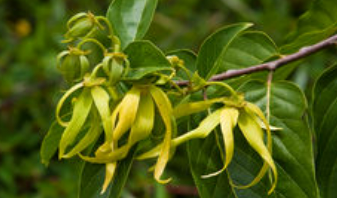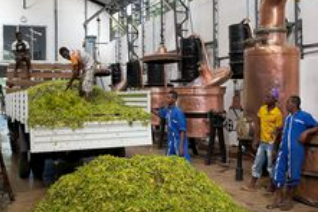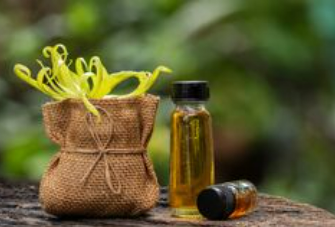- Home
- What Are Essential Oils?
- Ylang Ylang Essential Oil
Discover Ylang Ylang Essential Oil

Ylang ylang essential oil is extracted from the flowers of the Cananga odorata tree, which is native to tropical areas of Asia, including the Philippines, Indonesia, and Polynesia. This oil is highly valued for its fragrant and therapeutic properties, making it a popular ingredient in perfumes, cosmetics, and aromatherapy products. In this article, we will explore the main chemical compounds found in ylang ylang essential oil, its potential health benefits, and how to use it.
Extraction Process of Ylang Ylang Oil

Ylang ylang essential oil is extracted from the flowers of the Cananga odorata tree through a process called steam distillation. The process typically takes several hours to complete and involves the following steps:
- Harvesting the Flowers: Ylang ylang flowers are harvested early in the morning when their essential oil content is at its peak. The flowers are carefully handpicked to avoid damaging them.
- Preparing the Flowers: The harvested flowers are then cleaned and sorted to remove any debris or damaged petals. They are then left to dry in the shade for several hours to reduce their moisture content.
- Distillation: Once the flowers are dried, they are placed in a still and subjected to steam distillation. The still is heated, and steam is passed through the flowers, causing the essential oil to vaporize.
- Condensation: The steam and essential oil vapors are then cooled and condensed back into a liquid form. The essential oil floats on top of the condensed water and is separated from it.
- Fractionation: The essential oil is then subjected to a process called fractional distillation, which separates it into different grades based on its chemical composition and aroma. The highest grade of ylang ylang essential oil, called "Extra," is obtained from the first distillation, while lower grades are obtained from subsequent distillations.
- Filtration and Bottling: The final step in the process is filtration and bottling. The essential oil is passed through a filter to remove any impurities, and then bottled and labeled for sale.
The steam distillation process is the most common method used to extract ylang ylang essential oil, as it allows for the extraction of a high-quality oil while preserving its delicate fragrance and therapeutic properties.

Chemical Compounds In Ylang Ylang Essential Oil
Ylang ylang essential oil is composed of a complex mixture of chemical compounds, including esters, terpenes, alcohols, and ketones. The primary chemical components of ylang ylang essential oil are benzyl acetate, linalool, and germacrene D. Other notable compounds include benzyl benzoate, geranyl acetate, and eugenol. The unique combination of these chemical compounds gives ylang ylang essential oil its distinct aroma and therapeutic properties.
What Are The Health Benefits of Ylang Ylang Essential Oil?
Ylang ylang essential oil has been traditionally used in many cultures for its therapeutic properties. Here are some of the potential health benefits of this oil:
- Relaxation and Stress Relief: Ylang ylang essential oil is widely recognized for its calming and soothing effects. Its aroma has been shown to have a positive impact on mood and can help reduce stress and anxiety.
- Improved Sleep: The sedative properties of ylang ylang essential oil may help promote relaxation and improve the quality of sleep. This oil can be diffused in the bedroom or added to a warm bath before bedtime.
- Skin Care: Ylang ylang essential oil has antiseptic and anti-inflammatory properties, making it beneficial for skin care. It can help soothe skin irritations, reduce the appearance of blemishes, and promote a healthy, glowing complexion.
- Aphrodisiac Properties: Ylang ylang essential oil has long been used as an aphrodisiac due to its ability to increase libido and enhance sexual pleasure.
- Lowered Blood Pressure: Ylang ylang essential oil has been shown to have a beneficial effect on blood pressure levels. Its aroma has been shown to reduce stress and anxiety, which can help lower blood pressure.
What are the best ways to use Ylang Ylang Essential Oil?
Ylang ylang essential oil can be used in a variety of ways, depending on the desired effect. Here are some suggestions:
- Aromatherapy: Add a few drops of ylang ylang essential oil to a diffuser or vaporizer to create a relaxing and soothing atmosphere.
- Massage: Combine ylang ylang essential oil with a carrier oil, such as coconut or jojoba oil, and use it for a relaxing massage.
- Bath: Add a few drops of ylang ylang essential oil to a warm bath to help promote relaxation and improved sleep.
- Skin Care: Add a few drops of ylang ylang essential oil to your favorite moisturizer or serum to promote healthy skin.
- Perfume: Ylang ylang essential oil is a popular ingredient in many perfumes and can be used as a natural alternative to synthetic fragrances.

What does Ylang Ylang smell like?
The smell of ylang ylang essential oil is sweet, floral, and exotic. It has a rich, heady aroma that is often described as romantic and sensual. The scent is complex, with notes of jasmine, neroli, and banana, as well as subtle hints of spice and wood. The intensity of the fragrance can vary depending on the quality and age of the oil, with older oils having a more intense aroma. Overall, the scent of ylang ylang essential oil is warm, inviting, and uplifting.
What other essential oils does Ylang Ylang Essential Oil blend well with?
Ylang ylang essential oil blends well with a variety of other essential oils, including:
- Bergamot: This citrus oil has a refreshing, uplifting scent that complements the floral notes of ylang ylang.
- Geranium: Geranium oil has a similar floral aroma and is often used in skincare products.
- Lavender: Lavender oil has a calming and soothing aroma that blends well with ylang ylang's relaxing properties.
- Patchouli: Patchouli oil has a musky, earthy scent that can add depth and complexity to ylang ylang's sweet aroma.
- Sandalwood: Sandalwood oil has a warm, woody scent that can enhance the sensual qualities of ylang ylang.
- Jasmine: Jasmine oil has a rich, floral scent that pairs well with ylang ylang's sweet, exotic aroma.
- Rose: Rose oil has a delicate, floral fragrance that can enhance the romantic and feminine qualities of ylang ylang.
When blending ylang ylang with other essential oils, it's important to start with small amounts and experiment until you find the desired scent and therapeutic effect.
In conclusion, ylang ylang essential oil is a versatile and beneficial oil that can be used for its calming, soothing, and therapeutic properties. With its unique combination of chemical compounds, it has been shown to have a positive impact on mood, skin health, and blood pressure levels. When using ylang ylang essential oil, it is important to dilute it with a carrier oil and use it in moderation.
Enter your email below and I’ll share new articles, reflections, and practical insights as they’re published.


